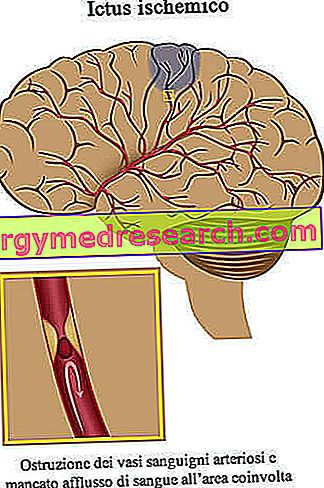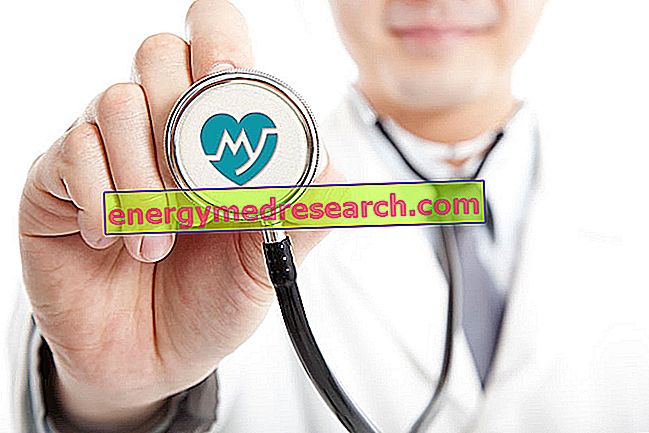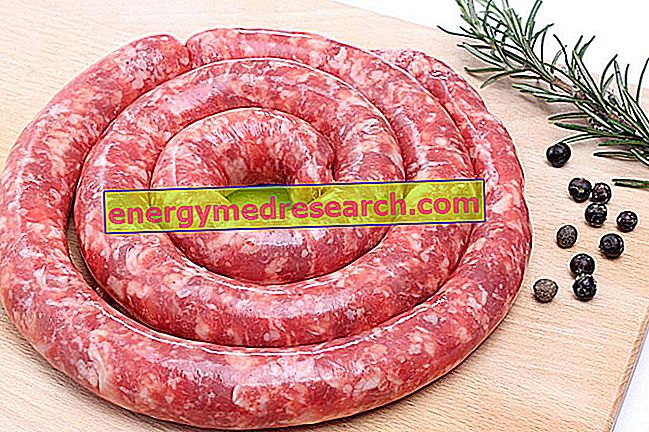Generality
An embolism is an interruption of blood flow, due to the presence of a mobile and insoluble foreign body, such as a blood clot, an air bubble, a lump of fat or amniotic fluid, a cholesterol crystal, a talcum powder, etc.

Scheduled only after careful diagnosis, the treatment of an embolism depends on at least three factors: the cause of the obstruction, the size of the emboli and the site of the obstruction.
What is embolism?
Embolism is the medical term that indicates any interruption of the blood flow, at the level of the arterial or venous vessels, due to the presence of a mobile and insoluble foreign body, such as a blood clot, an air bubble or a lump of fat.
In medicine, any mobile and insoluble foreign body, which interrupts the flow of blood along the arteries or veins, is called the embolus .
Embolism phenomena can be lethal for the victim, as they reduce or prevent the flow of blood to one or more organs.
The most serious consequences and the greatest risk of death occur when the embolism affects vital anatomical elements, such as the brain, lungs or heart.
SOME MORE DETAILS ABOUT EMBOLIES
Emboli travel through the vast network of arteries and veins in the human body, exploiting blood circulation.
If they have large dimensions, they cannot reach the blood vessels of small-medium caliber; on the contrary, if they are small, they can also wedge in the arteries and in the smaller veins.
An embolus represents an obstacle to the flow of blood, when it is wedged into a blood vessel of similar size: in these situations, in fact, it is no longer able to continue its run and acts as a cork.
MOST COMMON EMBOLIES
The most common embolism phenomena concern:
- Arterial vessels that supply the brain.
The interruption or reduction of the blood supply to a brain area takes the generic name of stroke . If the stroke is due to the presence of an embolus, it is called an embolic ischemic stroke .
- Blood vessels that carry oxygen-poor blood from the heart to the lungs (pulmonary arteries or their branches).
When an embolus obstructs the patency of the pulmonary arteries or their branches, the doctors talk about pulmonary embolism .
It is recalled that the function of the pulmonary arteries (and their branch) is to transport oxygen-poor blood to the lungs (precisely to the pulmonary alveoli), to charge it with oxygen.
- Arterial blood vessels that feed the tissues of the heart (the so-called coronary). The condition characterized by the obstruction of the coronary arteries, due to one or more emboli, is called coronary embolism . A coronary embolism can give rise to a heart attack.


It is a widespread tendency to confuse the phenomenon of embolism with the phenomenon of thrombosis .
If the term embolism indicates the presence, in the blood, of a non-soluble movable body, the word thrombosis refers to the stable presence, on the wall of an artery or vein, of a blood clot, which takes the specific name of thrombus .
If it reaches certain dimensions, a thrombus can hinder blood flow to the point of depriving the organs and tissues of the blood needed, supplied by the vessel concerned.
As in the case of an embolism, the consequences of a thrombosis can also be lethal for the subject who is affected.
The confusion between thrombosis and embolism arises from the possibility that from the first condition the second arises: in fact, it is possible for a thrombus to come apart giving rise to one or more mobile blood clots, in other words to emboli.
In light of what has been said above, the phenomenon of embolism is, in certain aspects and in specific situations, a complication of thrombosis
Causes
The causes of embolism are numerous.
In fact, it can form an embolus and block the flow of blood, inside a vessel:
- A blood clot . Blood clot embolism is the most known and widespread;
- A lump of fat . Embolism caused by a lump of fat is called a fat embolism.
- An air bubble (or a gas bubble ). Embolism resulting from the presence of an air bubble inside a vessel is known as a gas embolism.
- A crystal of cholesterol . The embolism following the presence of a cholesterol crystal is known as cholesterol embolism, an embolism from cholesterol crystals or atheroembolism.
- A lump of amniotic fluid . The resulting embolism is called an amniotic fluid embolism.
- A granule of talc . The resulting embolism is called, very simply, talc embolism.
- A parasite (eg: tapeworm) or a group of parasites (eg: agglomeration of pyogenic bacteria). Embolism arising from one or more parasites is known as a septic embolism.
- A foreign body like a splinter or a needle .
EMBOLIA FROM COAGULO SANGUIGNO
The mechanism of blood coagulation is a physiological response of the organism, in the presence of wounds or cuts to a tissue, to avoid excessive blood loss.
Blood clots are the result.
The coagulation process involves a group of particular blood cells - the so-called platelets - and a class of equally particular enzymes - the so-called coagulation factors .
Due to certain health conditions - including obesity, heart disease, cancer or pregnancy - human beings can be the victim of unnecessary blood clotting phenomena, that is without there being a loss of blood to stem.
The resulting blood clots can be deposited in a vessel (thrombus) or travel through the wide vascular network of the human body, using blood flow (embolus).
Blood clot embolism is a possible consequence of the events described above.
A particular form of thrombosis, which specifically concerns the veins of the legs and which takes the name of deep vein thrombosis, is one of the main causes of pulmonary blood clot embolism.
In such situations, the embolus that obstructs the pulmonary arteries or one of their branches derives from the cleavage of a thrombus, formed in a deep vein of the lower limbs.
GREASE EMBOLIA
In cases of fat embolism, the lump of fat that plays the role of embolus derives from the adipose tissues of the human body. Generally, once it has penetrated the bloodstream, it joins platelets and red blood cells, forming an even more consistent mass.
In most circumstances, fat embolism occurs as a result of very severe traumatic injuries, such as long bone fractures (tibia or femur) or high-grade burns.
More rarely, it may be the effect of:
- Orthopedic procedures, such as hip replacement or knee prosthesis;
- Bone biopsies;
- Episodes of pancreatitis;
- A condition of fatty liver;
- Emoglibinopatie;
- Liposuction interventions;
- Prolonged administration of corticosteroids;
- Osteomyelitis.

EMBOLIA GASSOSA
The bubble or the bubbles that cause the phenomena of gas embolism are the result of particular pressure conditions, which favor the entry of a gas into a blood vessel, exposed to the air.
In other words, if an artery or vein is in contact with air and certain pressure conditions exist, atmospheric gases can penetrate the aforementioned artery or vein and generate bubbles.
The pressure conditions, capable of giving rise to a gaseous embolism, can occur at:
- A venous injection, by syringe, poorly practiced . The gas embolism due to the misuse of syringes is very rare.
- Surgical procedures that require the insertion of central venous catheters in the subclavian vein or in the jugular vein . To cause the formation of air bubbles is precisely the maneuver with which the doctors insert the aforementioned catheters.
Brain surgery is the surgical procedure most at risk of air embolism. According to an accredited scientific journal - the Journal of Minimal Access Surgery - 80% of brain operations cause episodes of gas embolism, which doctors treat before the conclusion of the intervention.
To try to prevent the formation of air bubbles at the time of insertion of the venous catheter, the doctors make the patient assume the so-called Trendelenburg position.
- Artificial ventilation, practiced during severe chest trauma . The strong trauma to the chest involves a vascular lesion such that the air introduced, through artificial ventilation, filters into the vessel or in the injured vessels and forms the bubbles.
- Scuba diving . The prolonged stay underwater of a diver involves the accumulation in his blood and in his tissues of huge quantities of nitrogen; this nitrogen comes from the air contained in the underwater breathing tanks.
The presence of massive doses of nitrogen and the non-elimination of the latter can lead to the formation of gaseous bubbles in the blood and / or tissues.
- Other (pulmonary barotrauma, bomb blast, sexual intercourse, etc.).
CHOLESTEROL EMBOLIA
Cholesterol crystal embolism is a phenomenon that mainly affects people who suffer from severe atherosclerosis .
Usually, it originates from the detachment of a portion of atherosclerotic plaque and from the spread of this portion in the circulatory stream.
More rarely, it represents a complication following vascular surgery and angiography operations.
EMBOLIA FROM AMNIOTIC LIQUID
Amniotic fluid embolism is a rare complication of pregnancy, which occurs when a lump of amniotic fluid passes into the circulatory stream.
The passage of a lump of amniotic fluid in the blood is more likely to occur in certain specific moments or circumstances of gestation:
- During labor;
- Immediately after giving birth;
- Following an abortion;
- After an amniocentesis.
In general, the phenomena of embolism due to amniotic fluid affect the pulmonary arteries (pulmonary embolism from amniotic fluid) and, therefore, cause dyspnea and heart failure.
Fortunately, according to some estimates referred to North America, pulmonary embolism due to amniotic fluid has a frequency of one case for every 15, 000 pregnancies.
EMBOLIA FROM TALC
The so-called talc embolism is a condition that could be incurred by those who abuse injectable drugs, such as heroin. Indeed, those who prepare narcotics of this type mix the narcotic drug with talc and other substances.
Once in the bloodstream, talc can reach the smaller blood vessels - including capillaries - and trigger a particular immune reaction, which gives rise to the so-called " foreign body granulomas ".
In the case of talcum pulmonary embolism, the presence of foreign body granulomas alters the normal anatomy of the pulmonary blood vessels, affecting the normal oxygenation of the blood, at the level of the lungs.
Risk factors
Among the risk factors for embolism, doctors include:
- Overweight and obesity;
- Advanced age;
- Cigarette smoke;
- The presence of some heart disease;
- Prolonged immobility, due for example to serious illnesses, bone fractures or long journeys by plane or car;
- The state of pregnancy.
Symptoms and Complications
The symptoms and signs of an embolism are very varied and depend on where the embolus obstructs the flow of blood.
Below, readers will be able to consult a list of the typical symptom picture of the three most common embolisms: embolic ischemic stroke, pulmonary embolism and coronary embolism.
EMBOLIC ISCHEMIC ICTUS
The possible typical manifestations of the embolic ischemic stroke are:
- Paralysis and numbness of the face and / or limbs;
- Difficulty walking;
- Difficulty speaking and understanding;
- Visual difficulties;
- Headache.
The most important complications include:
- Total or semi-total paralysis of the motor muscles;
- Serious difficulty speaking and swallowing;
- Loss of memory and inability to reason;
- Emotional problems and behavior change;
- Post-stroke pain;
- Inability to care for oneself.
Remember that, regardless of the causes, the symptoms and signs of a stroke depend on the brain area that no longer receives the right blood supply.
PULMONARY EMBOLISM
The typical symptoms and signs of pulmonary embolism consist of:
- Dyspnoea
- Chest pain
- Cough
- Irregular heart beat and tachycardia
- Cyanosis
- Dizziness and dizziness
- Fainting
- Excessive sweating
The most important complication of pulmonary embolism is a very dangerous condition called pulmonary hypertension .
CORONARY EMBOLIA
The symptomatological picture characteristic of coronary embolism includes:
- Chest pain (due to the peculiarities of this pain, the reader is advised to read the article present here);
- Dyspnoea;
- Nausea;
- He retched;
- Weakness;
- Dizziness;
- Cold sweats;
- Confusional state;
- Fainting.
The most important complication of coronary embolism is an arrhythmia, often lethal, known as ventricular fibrillation .
Diagnosis
An embolism diagnosis may require a wide variety of examinations and tests.
Surely, they represent two cornerstones, for the information they provide, the physical examination and the medical history.
Imaging diagnostic tests are also very important, including: ultrasound, CT, nuclear magnetic resonance (NMR) and angiography.
It is only thanks to an accurate diagnostic procedure that doctors can plan an appropriate therapy.
Treatment
In general, treatment of an embolism depends on at least three factors:
- The cause of the obstruction ;
- The size of the emboli ;
- The site of the obstruction .
Among the possible therapeutic options, a surgical operation known as embolectomy, drugs for the dissolution of blood clots (when these are the cause of embolism) and hyperbaric chamber treatment (when the cause of the embolism is a air bubble).
embolectomy
Embolectomy is a surgical operation to remove the emboli or occlude a blood vessel, usually an artery.
It is a very delicate procedure, not without side effects and still burdened by a more than moderate mortality rate. Its execution is reserved for extreme cases or for which pharmacological therapy (eg fat embolism) is considered useless.
DRUGS FOR THE DISSOLUTION OF BLOOD COAGULES
Drug therapy for the dissolution of blood clots includes anticoagulant drugs and thrombolytic drugs .
The anticoagulant drugs (eg low-molecular heparin and warfarin) have the power to slow down or interrupt the blood clotting process, while the thrombolytic drugs possess the property of dissolving the blood clots already present.
In general, doctors give precedence to anticoagulant therapy, as it has a lower risk of adverse effects, compared to a thrombolytic therapy.
IPERBARIC ROOM
The hyperbaric chamber (or chamber for hyperbaric therapy ) is a room in which it is possible to breathe 100% pure oxygen at a pressure higher than normal.
It is one of the most suitable treatments in the case of gas embolism, since, by acting on the blood pressure, it eliminates the air bubbles or bubbles circulating in the blood.
Prevention
Adopt a healthy diet, limit salt consumption, maintain a normal body weight, not smoke (or stop smoking, if you are a smoker) and practice at least 150 minutes of physical activity a week are the main indications that doctors provide information on reducing the risk of embolism.
At present, preventing phenomena of embolism with absolute certainty is impossible.



